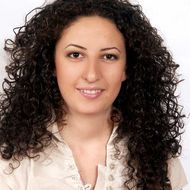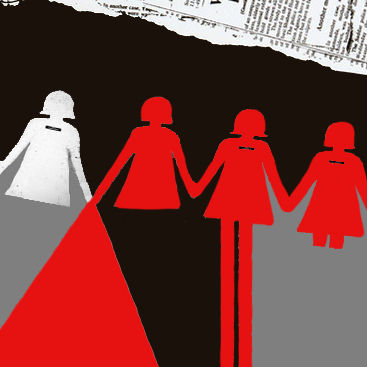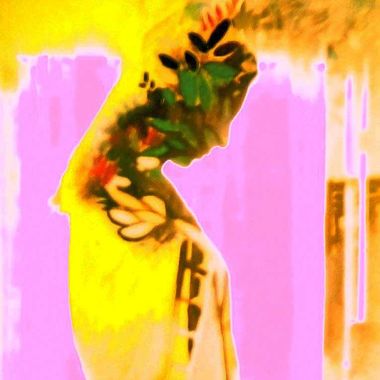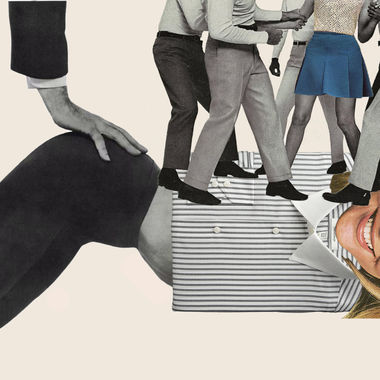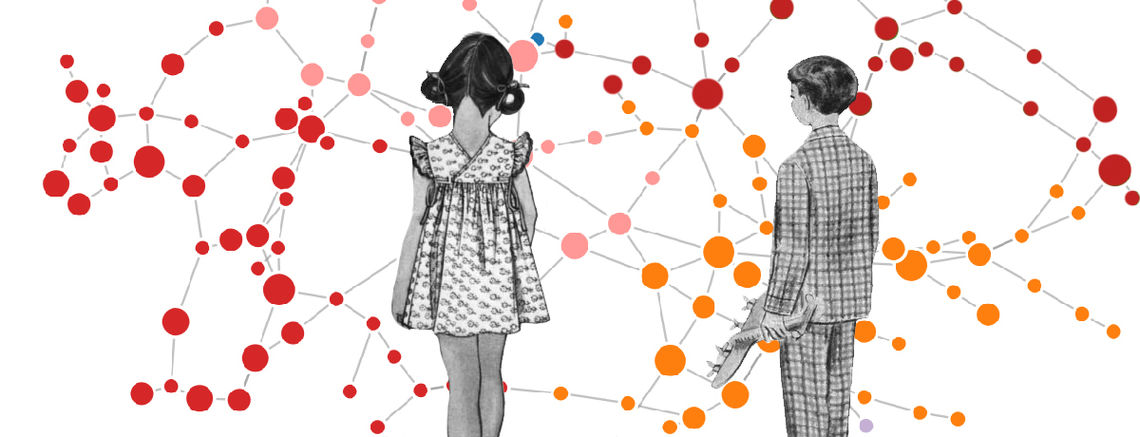
In one of Yerevan’s central streets a scuffle between an elderly man and a young child had passersby concerned. After calling the police, they gathered around the pair trying to understand the baffling situation.
I was walking down the street with my colleague at the time. We cut our heated discussion short when we noticed the mass of people on the sidewalk. We thought someone wasn’t feeling well. A few moments later, my friend noticed the young child and how thinly he was dressed.
Being a journalist, I introduced myself and approached the older man and child.
Witnesses and policemen were trying to understand what had happened. Two women claimed that they saw the elderly man hitting and dragging the 5-6 year old child through the streets. They decided to intervene by reprimanding him and calling the police. I can only imagine what an awful scene it must have been to have prompted the women to call the police.
I asked the man if he was the child’s grandfather. With an indifferent tone, he assured me he was. When I asked why the child was dressed so lightly in this cold weather, he indignantly responded that it was quite the opposite. “They overdress the child so much he suffocates,” he said. When we inquired where the child’s parents were he told us that they weren’t here and he had decided to take the child to Republic Square to see the Christmas tree.
I approached the child and tried to interact with him. In half-Russian, half-Armenian he whispered in my ear that this man was bad, very bad, and he didn’t want to go with him. This unsettled me. Then I remembered that my three-year-old son had called me and his father very bad and that he didn’t love us after we forbade him from watching his favorite cartoon. At that age children are prone to fabricate, blame and become upset.
However, this year alone I knew that there were three cases of missing children. One of them was never found, one’s body was found in a water canal, and the third, after a long search, was found and returned to the family.
It was probably news of these incidents that compelled the women to stop what they were doing and try to deal with a situation where a child wasn’t complying with his grandfather.
The police questioned the man trying to get to the bottom of the matter. Not satisfied with his responses, they finally decided to take him to the police station. I asked to join them, but was not permitted. I asked one of the policemen to provide me a number that I could call later to find out how this story would finally end.
When I called later, I was told that the child’s parents had also come to the police station. They were at work during the incident. Everything was resolved. They have all gone home I was told.
The next day I tried to get information about the child and grandfather from the police. Naturally, they avoided my questions and assured me that everything was fine and the case in question had been closed. The case was closed. However, at least for me, a random passerby, a long list of questions remain unanswered.
Closed Cases and their Irreversible Consequences
It is difficult to say how many similar cases take place every year and how many are so “skillfully” resolved. However, cases that are so quickly “closed” cannot be without consequence.
Experts assure us, violence is not a one-time incident and takes place repeatedly.
Recently in Armenia there have been many discussions about the preservation of the traditional Armenian family and traditional values. These discussions usually ignore the issue of violence. It is considered a “fake agenda” imported from abroad, the aim of which is to disrupt the “peace” of the Armenian family.
Meanwhile, it’s a whole other picture when we look at the numbers in Armenian police reports and research done by NGOs. These numbers are only the tip of the iceberg. It turns out that our children are victims to not only physical and emotional abuse, but sexual abuse as well. Abuse takes place in the home, in schools and in public places.
During the first four months of 2017, 59 incidents of child abuse were registered in Armenia; 24 of them were sexual abuse. During the first four months of 2016, 71 incidents of underage child abuse were registered, 34 of them sexual abuse. Cases of reported abuse within the home were also registered by police: During the first five months of 2018, police recorded three incidents of underage child abuse within their home. In 2017 and 2016, four underage children were victims of abuse inside the home.
During the first eight months of 2014, 138 incidents were recorded of underage child abuse. Seven of them took place inside the home.
According to a survey conducted in 2015-2016 on Armenia’s demography and health, one out eight children between one to 14 years of age, were victims of some sort of emotional or physical punishment within the previous 30 days of the conducted survey.
Ominous Numbers
On September 28, 2018, 32-year-old Rustam Manukyan beat his wife and one-year-old son, Arman Grigoryan. The child did not survive his injuries and died on the way to hospital.
In December, 2016, news broke that in August of that year an eight-year-old girl had been severely beaten by her father for not going to the store to buy him beer. The father apparently regularly beat his wife and three underage children. For causing deliberate bodily injuries to the girl, the court decided to place travel restrictions on the father as probation and to pay a fine of 30,000 AMD (about $60 US).
On December 19, 2016, a hanging woman’s body was found in her home in the city of Spitak. In the bedroom of her apartment they also found her two daughters, dead. The girls were five and seven-years old. According to preliminary reports, the woman strangled her two daughters and then killed herself. The 45-year-old woman was once a patient at the psychiatric ward in the State Clinic of Spitak in 2013. After divorcing her husband, the children were left under her care.
On February 9, 2015, according to official accounts, a 47-year-old woman in Yerevan decided to burn down her house as revenge against her husband who worked abroad. Days later she died in hospital. Her nine-year-old son was saved, despite receiving severe burns. Later it became known that she had struck her son’s head with a hammer and then set the apartment on fire by dousing it with gasoline.
These numbers may seem like plain statistics. But behind these numbers are lives not lived. Lives that may have continued if there were responsible bodies who worked professionally and on time.
In all these cases, investigative journalists have discovered that neighbors, relatives and even the police were aware of the abuse taking place within the home. However, allowing the abuser to get away and failing to stop an inevitable crime, is difficult to comprehend.
A Five-Year-Old Child: Victim of Sexual Abuse
The Armenian Relief Fund, also known as HOF, is a child support center. Manane Petrosyan is the assistant director of the center and says that cases of emotional abuse are the most common they see. However, these cases are not always perceived as abuse and are not always reported. Lately, however, they’ve seen a rise in sexual abuse cases.
“Sexual abuse cases are mostly cases of incest,” she says adding that it’s very difficult to prove. “Of course, experts understand the situation, however their opinions are rarely taken into consideration in courts. We’ve had a case of a five-year-old child who was victim of sexual abuse. Usually it’s six to 15-year-olds who are abused sexually. However, cases of physical and emotional abuse takes place in all age groups.”
HOF works with 800 -100 children yearly. Near 200 children take shelter at the center, 80 percent of whom are children that have been abused.
“At our center a multidisciplinary group of experts work with children of abuse - psychiatrists, social workers, doctors, educators, etc. The team works with the child and the family,” Petrosyan explains. “Our primary goal is to ease the child’s trauma and return him/her to the family. However, that’s not always possible. For example, the father or grandfather sexually abused the child, which happens very often, or the mother’s boyfriend abused the child and the mother will not leave the boyfriend. Naturally, it’s dangerous to return children to these families.” Petrosyan says that they try to find other alternatives, which as a rule is appointing a guardian that is a close family member to provide the child with a familiar environment. “The second alternative is foster care. We send the child to another family. This is not adoption, legally the government continues to be the guardian of the child,” Petrosyan says. “In this case, the government pays the family and the child stays within a family model. The last alternative is sending them to an orphanage. This, of course, does not stem from the child’s best wishes and is the least desirable alternative for us.”
related
Domestic Violence: An Imperfect Law and Enduring Stereotypes
By Gohar Abrahamyan
Another case of a woman being killed by her husband has forced Armenian society to speak once again about the one thing it doesn’t like to address - domestic violence.
Breaking Intergenerational Violence Against Children in Armenia
By Lusine Sargsyan
UNICEF Armenia recently held a conference discussing child abuse in Armenia, a topic that is often not talked about. Based on the Demographic and Health Survey conducted in almost 8000 households in the country, the numbers of children experiencing physical and psychological abuse are quite alarming.
Impunity for Domestic Violence in Armenia’s Criminal Justice System
By Ani Jilozian
Domestic violence is a critical issue facing women globally, and women in Armenia are not immune from it. In this piece, Ani Jilozian of the Women's Support Center based in Yerevan highlights the current situation in Armenia and the importance of passing legislation on domestic violence.
Not What But Why: The Nature of Patriarchy
By Rafik Santrosyan
Gender discrimination is a deeply cultural problem, Rafik Santrosyan writes. The incident last month in Yerevan City Hall where a group of men beat a woman councilor highlight how patriarchal relations, toxic masculinity and internalized misogyny have influenced the public discourse.
Incompetence and the Fate of our Children
According to Article 7 of the Family Code of the Republic of Armenia, “The protection of the rights of family members is realized by judicial procedure, and in cases and procedure established by the Code, in accordance with state bodies or the departments of custody and guardianship.”
Departments of custody and guardianship are state community bodies that work under administrative districts, municipalities and community councils. However, for the past several years experts have been stating that these are fictive bodies that effectively don’t work.
“Unfortunately, these decision-making bodies don’t provide services, none of them work with the victims,” Petrosyan says. “Custody committees are voluntary bodies. Without any in-depth research they are making decisions for a child. There are objective and subjective reasons for this.” She goes on to explain, “These bodies have been given a mandate, but no resources. This means they have no knowledge - any random person can become a committee member. Plus, they have no financial resources. Lack of finance means they can’t visit distant communities. These communities require extensive work that cannot be done with one or two visits.”
The lawyer for the Coalition to Stop Violence Against Women, Stella Chandiryan, has noticed that the judicial system is also defective. She explains that there are investigators that work with children, however there are no available structures or judges or a separate subdivision within a prosecutor’s office or the court that specifically specializes in child abuse cases.
“There are legislative gaps that prevent identifying and solving these systemic issues,” Chandiryan notes. “Cases of abuse are mainly taking place within the family. However, we also see incidents when the abuse takes place between minors.” She says that most people believe that abuse is a one-time incident, however this is not the case. “Abuse is a crime and a public concern. The government has to take preventive steps against abuse and organize awareness campaigns,” she says. “The government has to say that if you hear your neighbor being beaten you should call the authorities, because a crime is taking place. You would most probably call the authorities if you heard gunshots. Cases of abuse should not be less important than other crimes.”
A Society that Doesn’t Interfere in the Affairs of Others
Three years ago, my family and I moved to one of the suburbs of Yerevan. The first person we met from our building was a boy whose name was well-known in the neighborhood. Often, his parents would call out to him from their window, other times noises would come from their apartment, or his friends would ask him to help “solve” an issue for them. More often than not, however, he would be reprimanded for his bad behavior, yet he would continue to curse and clash with others. Often, after midnight we would hear loud noises coming from the apartment where he lived, so loud that my child would jump out of bed in fear. Several times I considered calling the authorities, but then I would wonder if I should. I don’t know anyone from that family. I’ve only seen the child a few times in the courtyard. I didn’t give myself the right to meddle in the affairs of that family.
The reason is that from a young age we have been taught that you should not stick your nose in other people’s business. We all know quite well how many times fights break out in the neighbor’s house, in the building or in the courtyard. We all know how many women have wept and how many children have been struck. However, we keep ourselves away from these issues. Often we sit around a cup of coffee and discuss in detail the fights and problems other people have in their households. Maybe, instead of unnecessary gossip we should take a step and save a life.
Maybe while we’re discussing the latest scandal there is a life fading away…
Maybe...

